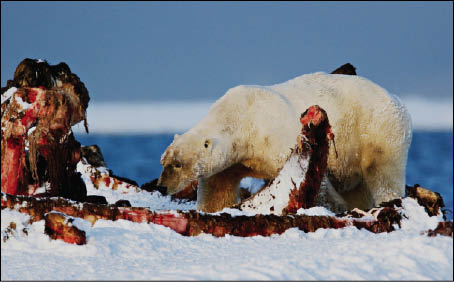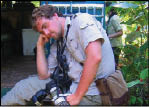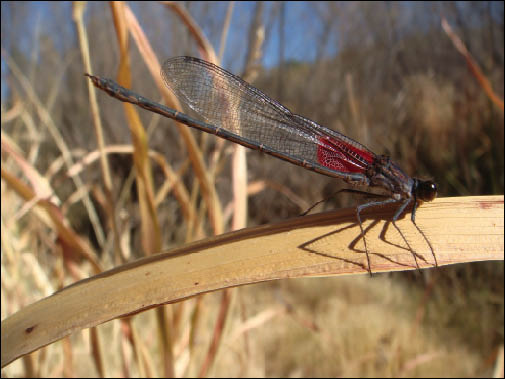Thoreau's Legacy (13 page)
Authors: Richard Hayes
Sea Bear
Blake Matheson
MASSIVE ANIMAL TRACKS—TWENTY INCHES FROM
heel to claw—push deep into the blue ice, luminous and crystalline in the gold of the Arctic sun. They are the unmistakable marks of Ursus maritimus—the great sea bear.
A hard west wind rolls over my back, then ripples out over snow-choked lagoons and frigid reefs. The gray horizon is broken only by a towering crimson spike. When I move closer, I realize it is the nine-foot-long rib of a bowhead whale, slaughtered by Inupiats in September. Each year the ice retreats farther from shore, and soon the leviathans will be out of hunters’ reach for the first time since man came to Barter Island.
The harsh and beautiful frontier we call the Arctic National Wildlife Refuge (ANWR) lies below me. In the summer months it is an expanse of warm russet tones rolling out from the roots of the mountains to the steely water of the Beaufort Sea. Beyond the Beaufort, few places carry men’s names until the Arctic Ocean transits the earth’s pole.
Now, in October, the auburn of the tundra has disappeared, succeeded by a white immensity broken only by black veins on the cracked heights of the Brooks Range and by the sun’s ephemeral light.
I follow the bear’s tracks toward the water’s edge. Atop a whale vertebra the eyes of a snowy owl break the scene’s gravity. Long-tailed ducks drift placidly in the last open water of fall. A flock takes flight, riding the wind to the southeast, the supple sound of air beneath their wings. I watch until they vanish in the opacity of a faraway mist.
From behind a rocky outcrop the old bear appears. Big shoulders propel his tremendous legs over swaths of gravel and ice, his stride unbending and stiff. Hunting has been difficult for him in recent years, and his blue-black lips hang loosely from a gaunt, tired visage. Aged he may be, but the 1,200 pounds of carnivore before me is no less daunting for all his hard-won years.
The bear’s head hangs low, then unexpectedly his eyes lift, meeting mine squarely, resolutely. A black fire burns deep within them, and he steps toward me. In the space between heartbeats, borne by ecstasy and silent terror, I know what it means to be human, to be vulnerable. He, too, knows what I feel. He has seen the terrified eyes of countless prey and savored the sweet, visceral smell of fear on the wind. But I am also aware of something else deep within, a stirring remembrance of man’s ancient place below animals of exquisite and terrible power. After all, it was just such bestial jaws that chased man into witting evolution. To these creatures, as to our shared earth, we humans owe nothing short of
everything
.
A gull screams. The bear turns away, and gray cloud eclipses the Arctic sun.

The old male bear wanders through a maze of bowhead whale remains at Barter Island on Alaska’s North Slope. Photo by Blake Matheson.

Blake Matheson
recently completed law school in Portland, Oregon. He plans to marry and to look for a job working on the legal protection of endangered species and their habitats.
Tiny Scales
Curtis Childs
I ALMOST STEPPED ON IT, IT WAS SO SMALL. IT MIGHT
have been a stick, lying on the sidewalk as the setting October sun shot red and gold through the oak leaves. But as I bent closer—look! Tiny scales! Could it be? The five-inch-long snake flailed and curled its soft body around my index finger as I picked it up. Every scale seemed flawless, thousands of miniature overlapping plates gliding across each other as the animal’s spine articulated. Carefully lifting my hand, I turned my face to gaze at the orange-red underside, confirming my guess.
A Michigan red-bellied snake. I hadn’t held one since I was a child. My friends and I could catch two or three of them in a day, setting up bricks and rocks in the baby pool and putting the snakes in there just to watch and enjoy. Woods surrounded our subdivision then, and an hour’s adventuring could lead the three or four of us to cornfields, swamps, and ancient stumps.
The red-bellies left when the bulldozers came. Even the big black garter snakes, which to my boyhood delight had haunted every corner of our yard, vanished.
The
wave of suburban development
swept north from Detroit to crash over us,
leaving in its wake strip malls and a gray satellite view when the froth finally receded.
I peered more closely at the snake as insects hummed in the field. Somehow, the red-bellies had come back. These tiny, fragile reptiles had survived the overturned fields, the cement trucks, the pollution, and the drained wetlands—cosmic events to a creature this minute. But as I set her down, I looked up at the blue expanse of atmosphere overhead, suddenly aware of the magnitude of what the red-bellies might soon face. A pregnant female might move quickly enough to avoid a car’s tires, but what would she do if statewide rain patterns shifted? Where will she hide if shorter winters trigger an ecosystem imbalance, and the invertebrate prey she needs to survive move away?
These little animals, so timid that they don’t even try to bite when held, miraculously survived the turbulence of human development. Will that triumph mean nothing in a couple of decades? Can red-bellies, and thousands of other species like them, to whom a football field is a day’s journey, do anything to grapple with the enormity of a changing atmosphere?
We can’t know for sure, but as I watched the snake slip up over the curb into the grass, I smiled at the perseverance she stood for. Thanks for making it, thanks for the past you gave me, I thought, as scenes from years ago flashed across my mind. Now what future will I give you?

Curtis Childs
has a degree in communication from Oakland University in Michigan. He has been a disc jockey for his college radio station and a performing singer-songwriter.
American Ruby-Spot Damselfly
Lea Jane Parker
I am an educator for a young people’s environmental club in Arizona. As I lead a Nature Quest hike along the Verde River, I delight in seeing
young faces light up
when they find animal prints, damselflies and other insects, birds, plants, and interesting rocks. As they listen to the water’s rushing music, they
learn about the impacts of global warming
and the need to protect ecosystems.

Lea Jane Parker
is a professor at Northern Arizona University, where she developed and teaches in the environmental communication program. She lives in Flagstaff, Arizona.

An American ruby-spot damselfly alights on a reed above the Verde River in Arizona.
Photo by Lea Jane Parker.
The Last Pika
Daniel T. Blumstein
I STUDY MARMOTS, BUT I WORRY ABOUT PIKA.
Although they look like small rodents, pika, known in Eurasia as “mouse hares” and in the United States as “tundra bunnies,” are lagomorphs—relatives of rabbits, as close examination of their teeth reveals. Pika live only on alpine and subalpine talus slopes. If you’re walking in a western alpine boulder field and worrying about twisting your ankle, you may be in pika country. They make a wonderful raspy squeal that sounds like a small squeeze toy. When I’m trapping marmots on the talus slopes,
I smile when I hear those squeals, the pika’s
territorial signals
and alarm calls.
One part of my research focuses on how climatic factors influence the behavior and survival of yellow-bellied marmots in Colorado. I work with a population of marmots that has been studied continuously since 1962. Some of my colleagues’ recent work has demonstrated that marmots are now emerging from hibernation earlier in the year and that this change is correlated with higher spring temperatures. Climate change may thus influence the timing of the marmots’ emergence. I recently discovered that their social behavior also influences emergence, a factor that may enhance or suppress the climatic effect.
Because I’m interested in how climate change may affect marmot behavior, people ask me if marmots will be influenced by global warming. My initial answer about the Colorado yellow-bellied marmots is a guarded no. No, because these marmots live in a 10,000-foot range of elevations, from the foothills of the Rockies to the top of almost every 14,000-foot peak I’ve climbed. (There they collect a “summit tariff”—your lunch—from human invaders.) No, because they live in a variety of habitats, and even with a drastic redistribution of habitats, which we anticipate global warming will generate, there will likely still be places for marmots to live.
By contrast, I tell people that I worry about pika. As the sagebrush climbs up the mountains and as tundra is lost to forest, I worry about where they will live and how they will find others of their species. Pika are habitat specialists, and it’s the specialists that will be most negatively influenced by climate change.
I worry that my grandchildren will not have the chance to laugh with glee when they hear their first pika, that they will not be able to smile with fond memories of wonderful experiences in high alpine ecosystems, which are as threatened as their habitat-specialist inhabitants. I worry about the last pika.

Daniel T. Blumstein
is an associate professor and vice chair of the Department of Ecology and Evolutionary Biology at the University of California, Los Angeles. He lives in Los Angeles and Gothic, Colorado, with his wife and son.